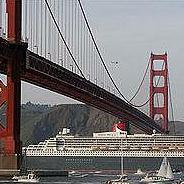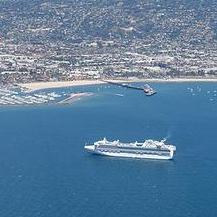 美國環保署訂出新的法令,將禁止大型郵輪與貨櫃輪在加州沿岸海域排放廢水。
美國環保署訂出新的法令,將禁止大型郵輪與貨櫃輪在加州沿岸海域排放廢水。
這項禁止排放法令,將設立全美最大的沿岸禁止排放區,預計每年可以在當地減少數百萬加侖的大型船隻廢水。
美國環保署區域長官布魯門菲爾德(Jared Blumenfeld)在25日宣布這項新措施的時候說,「加州沿海水域是美國獨特的珍寶。清澈的太平洋海水是加州經濟與生態活力的中心。」
「停止2000萬加侖的污水進入加州的海灣沿岸水域,可以保護人類和野生動物免受危險病原體的侵害,」他說。
「污水中的病原體、營養物質與其他污染物可能會影響環境、經濟甚至是人體健康。2009年對加州434處海灘進行的監測發現,有40%的海灘水質中病原體超過標準。超標的海灘包括洛杉磯全部的50處海灘、舊金山85%以上的海灘以及聖地牙哥75%的海灘。」
新的規定將在明年生效,旨在加強保護加州所有面積廣達5,222平方英里的港口和沿海水域,包含範圍從墨西哥邊界起直到奧勒岡州,以及主要島嶼周圍的水域。
這項禁令將禁止所有排水量大於300噸的船隻排放廢水,包含了在加州水域營運的郵輪與貨輪。
根據清潔水法案(Clean Water Act),各州可以要求環保局視需要設立船舶污水禁排放區,以保護並恢復水質。2006年,根據加州、奧勒岡州以及華盛頓州的減少船舶污水對其水域影響的法律,加州要求環保署頒布污水排放禁令。
 「大船帶來了更多的污染。但不幸的是,在加州,船舶並不需要對其排放的污水負責。」地球之友(Friends of the Earth)的海洋與船舶事務總監基弗(Marcie Keever)說道。
「大船帶來了更多的污染。但不幸的是,在加州,船舶並不需要對其排放的污水負責。」地球之友(Friends of the Earth)的海洋與船舶事務總監基弗(Marcie Keever)說道。
「這項由美國環保署、加州政府以及成千上萬名支持潔淨海岸法的加州居民所採取的行動,意味著郵輪公司及航運業不能再把加州的寶貴沿海和海灣水域當成他們家的馬桶。」基弗說。
但國際郵輪協會(Cruise Line International Association)表示,自2005年加州頒布自己的海岸污染防治法後,其成員航行於加州沿岸的船舶,就沒有在海岸線3英里內排放廢水。
相對的,這些郵輪會先將污水儲存,再利用案上的污水處理設備處理後排放,不然也會把儲存的污水排放在遠離海岸之處。
新的禁令將適用於所有離岸3英里內的沿海水域、所有的海灣以及河口感潮帶,和先前沒有設立禁排區的清潔水法案相比,新法所設立的限制區大多了。而目前加州有9個小型的禁排放區,其中包括了國家海洋保護區。
加州沿海水域包括了4個國家海洋保護區,一個國家紀念區,6個國家公園與遊憩區的一部分,和其他200多個已設立的海洋保護區和保留區,用以保護加州獨特的海洋資源。
其他船舶的污水排放,將繼續受到現行清潔水法案的管制,要求污水在排放以前,必須經過適當的衛生設備處理。州政府正在加強努力,以規範較小型船隻如遊艇等的污水排放問題。
All sewage discharges from large cruise ships and cargo ships to the marine waters along California's entire coastline will be banned under new rules proposed by the U.S. EPA.
The sewage discharge ban will establish the largest coastal No Discharge Zone in the country and is expected to eliminate millions of gallons of sewage that large ships release into local waters every year.
"California's coastal waters are a unique national treasure. The clear waters of the Pacific are central to California's economic and ecological vitality," said EPA Regional Administrator Jared Blumenfeld announcing the proposal Wednesday.
"Stopping 20 million gallons of sewage from entering California's coastal waters and bays protects people and wildlife from dangerous pathogens," he said.
Sewage contains pathogens, nutrients and other contaminants that can impact human health, the environment, and the economy. Of the 434 California beaches monitored in 2009, 40 percent experienced advisories for exceeding water quality standards for pathogens. Advisories were issued for all 50 Los Angeles County beaches, over 85 percent of San Francisco beaches, and 75 percent of San Diego beaches.
The new rule, which takes effect next year, is intended to strengthen protection for all 5,222 square miles of California's ports and coastal waters, extending from the border with Mexico to Oregon and the waters surrounding major islands.
The ban will prohibit sewage discharges from all vessels larger than 300 tons, including cruise and cargo ships that operate in California waters.
Under the Clean Water Act, states may request EPA to establish vessel sewage no-discharge zones if necessary to protect and restore water quality. In 2006, following passage of three state laws designed to reduce the effects of vessel discharges to its waters, the state of California asked EPA to establish the sewage discharge ban.
"Big ships make for big pollution but unfortunately, responsible disposal of sewage from ships hasn't always been a given in California," said Marcie Keever, Oceans and Vessels Campaign Director at Friends of the Earth.
"The actions taken by U.S. EPA, the state of California, and the thousands of Californians who supported the Clean Coast Act mean that cruise lines and the shipping industry can no longer use California's valuable coastal and bay waters as their toilet," Keever said.
But the Cruise Line International Association says its ships that sail along the coast of California have not discharged sewage within three miles of the shoreline since 2005 when the state passed its own coastal contamination law.
Instead, the cruise ships store sewage in holding tanks for discharge at municipal wastewater treatment facilities or for dumping farther offshore.
The new ban will apply to all coastal waters out to three miles from the coastline and all bays and estuaries subject to tidal influence, in contrast to prior no-discharge zones under the Clean Water Act, which apply in very small areas. There are nine small no-discharge zones currently designated in California, which include the national marine sanctuaries.
California's coastal waters encompass four national marine sanctuaries, a national monument, portions of six national parks and recreation areas, and more than 200 other marine reserves and protected areas have been established to protect California's unique marine resources.
Other vessel sewage discharges will continue to be regulated under existing Clean Water Act requirements, which require that sewage to be treated by approved marine sanitation devices before discharge. The state is strengthening other efforts to address sewage discharges from smaller vessels, including recreational boats.
全文及圖片詳見:ENS報導


